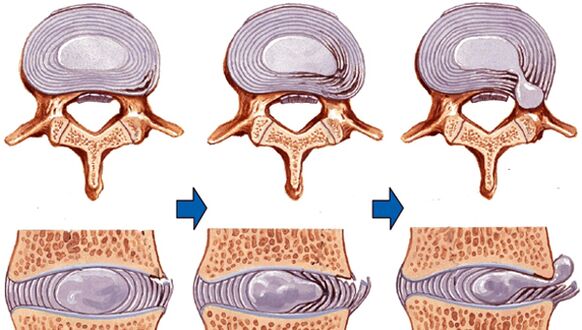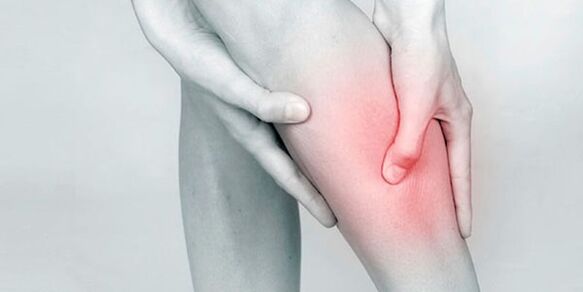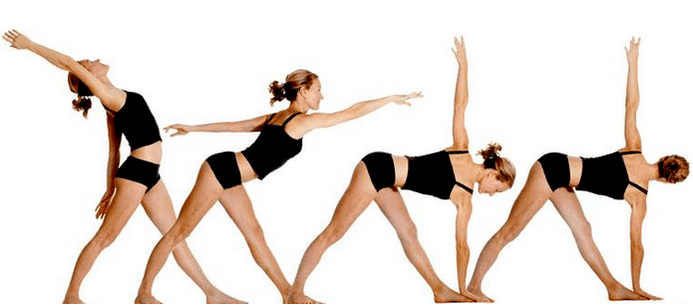The story of how the king treated osteochondrosis has survived to this day. 150-200 grams of mustard were added to a huge bowl filled with hot water, and the king, who was a great hunter for pleasant and useful entertainment in the heated bath, slowly sank to his neck. The procedure ended with a tea party.

The next day, the ruler was ready for the next military campaign.
What is osteochondrosis and how is it treated today?
"Extra" risk of disease
Osteochondrosis makes a person inflexible - a subtle aphorism accurately describes the consequences of degenerative changes in the intervertebral disc, the progression of which leads to its destruction.
The intervertebral disc, which gradually loses its ability to "roll", is covered with cracks as a result of increasing pressure, and the contents "squeeze" over time - an intervertebral hernia is formed.

Leaking fluid squeezes the nerve endings of the spinal cord, breaking the "connection" between all the internal organs of a person. Thus, osteochondrosis of the thoracic region takes years to treat gastritis or to look for the cause of heart pain; Lumbar or lumbosacral osteochondrosis can cause partial or complete paralysis of the lower extremities, while the cervix complicates the blood supply to the brain.
Sometimes the disease affects several sections of the "pillar of life" - the development of widespread osteochondrosis of the spine, treatment standards are similar to those described below, but the recovery process requires more effort by patients and doctors.
Cartilage tissue and the bones of the joints of the legs also suffer from destructive processes. Lumbosacral osteochondrosis is associated with shooting pain during movement, cramps and pain in the calf muscles, numbness of the toes, and decreased sensitivity of the skin of the feet.

However, more often these symptoms indicate osteochondrosis of the foot, treatment begins with a visit to a neurologist and is successfully carried out with the help of classical massage, manual therapy, osteopathy and acupuncture.
And how to treat osteochondrosis of the spine? Indeed, over time, the body compensates for the "missing" height of the discs by the growth of bone tissue in the spinal cord, and as they grow together, such growths immobilize individual segments of the "axis of life. "
How to treat exacerbation of osteochondrosis?
In addition to the rapid relief of pain, the main goal of treatment of exacerbated osteochondrosis is to relieve muscle spasms and combat swelling of the inflamed tissues that compress the nerve roots.
Modern standards for the treatment of osteochondrosis in the acute period prescribe treatment aimed at relaxing the spine and relieving pain:
- In the acute period, especially in the case of an intervertebral hernia, the patient is treated with one position - severe bed rest for at least 6 days;
- Painkillers help relieve inflammation and pain; analgesics, as well as NSAIDs, are usually prescribed for osteochondrosis;
- With persistent, severe pain syndrome, an anesthetic injection with glucocorticoids or novocaine is indicated. With acute osteochondrosis, these drugs have a long-term analgesic effect;
- In osteochondrosis with unbearable pain, insomnia, the use of hypnotics and tranquilizers is recommended;
- Central hypertensive muscle relaxants are prescribed with hypertonicity of the muscles of the back and lower extremities;
- When performing spinal decompression, diuretics are used to relieve swelling;
- Topical treatment of pain in osteochondrosis is provided with ointments and gels with anti-inflammatory components. They are applied at the site of pain localization;
- Angioprotective drugs and venotonics, as well as nicotinic acid, which is a vasodilator, are prescribed to optimize the blood supply to the spine;
- Surgery is often the only solution for paralysis.
Where do we treat osteochondrosis?
As a rule, the patient goes through a kind of circle - in the hospital - treatment in the clinic - hydropathic or in a sanatorium - treatment at home under the supervision of a doctor.

Often, even in the acute period, treatment is carried out at home, but the low effectiveness of the listed therapeutic measures solves the problem of hospitalization of the patient.
Recovery period for osteochondrosis
After an acute period, efforts should be focused on preventing destructive processes and optimizing local blood flow and metabolism. The expected result of treatment is maximum recovery of cartilage tissue.
The goal of the next phase of treatment of osteochondrosis is to prevent further degeneration of the soft "components" of the spine, to eliminate the consequences of neurological complications, and to prevent future exacerbations.
How do we treat osteochondrosis during recovery?
At this stage, the reception of pharmaceutical drugs continues. The most important of them are vitamins A, E, P, C and most of the "representatives" of the B group, which strengthen the walls of blood vessels and restore the normal "course" of nerve impulses, as well as chondroprotectors. The latter are cartilage extracts - a kind of pill for osteochondrosis, which stimulates the regeneration of "sagging" of cartilage tissue. They often contain an anti-inflammatory component, which allows you to reduce the dose of NSAIDs. Chondroprotectors are taken without exacerbation of pain syndrome.
To increase the effect of oral chondroprotectors, it is recommended to use a cream for osteochondrosis, as well as ointments based on chondroitin and glucosamine.

Patches are a relatively new and good remedy for osteochondrosis.
Small pieces with a sticky surface help to retain heat, anesthetize and slow down the destructive processes at the site of adhesion:
- Chinese patches for osteochondrosis contain herbal ingredients and beeswax, accelerate the final collapse of inflammation and relax the muscles. With the disappearance of pain, metabolic processes are normalized, and with them - the trophism of the affected segment;
- Pepper plaster for osteochondrosis stimulates blood supply to the problem area due to the presence of "burning" belladonna, pine rosemary and pepper, relieves muscle spasms and accelerates the swelling of tissues that compress nerve roots;
Physiotherapy and alternative therapies
As the inflammation decreases, in the presence of complications of osteochondrosis, further rehabilitation is carried out by non-pharmacological methods. The emphasis in treatment shifts to physiotherapy and alternative methods.
The main purpose of this period is to expand the engine mode.
How to get rid of osteochondrosis without medication:
- Physiotherapeutic procedures - infrared laser, magnetotherapy, phonophoresis with chondroxide help to eliminate the symptoms of muscle hypertension and "tension" of the nerves, as well as allow the direct delivery of chondroitin to the unhealthy segment, which prevents the destruction of cartilage tissue;
- Effective treatment of osteochondrosis rarely occurs without pulling or stretching the spine under the influence of its own weight, additional load or chiropractic forces. The most accessible method of spinal traction, especially when combined with osteochondrosis flexion, is to hang on a horizontal bar. But even this simple exercise technique is fraught with complications if it goes wrong, so any traction method should be discussed with your doctor;
- It is also possible to improve the blood supply to the spine and normalize metabolic processes by pointing with thin needles to the plexuses of nerve endings, blood vessels and connective tissues. In addition, acupuncture for osteochondrosis leads to the release of endogenous opiates that act as analgesics, as well as the production of "anti-inflammatory" cortisol, which eliminates the need to administer a synthetic counterpart. Gradual relaxation of the paravertebral muscles also helps reduce pain;
- Often, the treatment of osteochondrosis becomes a "life's work" and patients who have tried many ways to alleviate the pain leave positive reviews about the therapeutic properties of apitoxin and bee products.
Thus, therapeutic doses of bee venom significantly reduce inflammation and relieve pain more effectively than analgesics and NSAIDs, promote vasodilation and nutrient acceleration.
What is impossible to recover without?
Perhaps daily work was not your priority before the onset of the disease. During the recovery period, the "renewal" of the mechanism of natural aging is not possible without adherence to the schedule of rest, nutrition and physical activity.
Therefore, learn the hygiene of postures and movements - observing it in everyday life will allow you to "empty" the spine.

A place to sleep
Start by organizing a night's rest. In the acute phase, place a stiff shield under an ordinary mattress. Which mattress should be used for osteochondrosis in the future?
In the absence of posture deformities - orthopedic. In the presence of curvature, the bed should be stiffer.
The use of orthopedic pillows is recommended for osteochondrosis of the cervical spine.
After bed rest, the patient is advised to use a corset - in case of osteochondrosis, it loosens the affected segments, preventing spasms of weakened muscles. Its duration is determined by a doctor.
Nutrition
Review your diet. Maybe a springboard for recovery, if not ideal before. . . there will be famine. It is known that the first fast aggravates the disease, and the next fast cures it. How does fasting treat osteochondrosis? In fact, the intervertebral disc is a small hydraulic shock absorber. Like the water bag, the disc pads are also affected. Alternate compression and release of pressure on the disc hydrates it.
According to the author's method, dry fasting helps to remove "waste" and "dead" water from the tissues surrounding the disc and stimulates the renewal of its own, purified intercellular fluid.
Fasting should be performed under the supervision of a physician.
physical education
The best remedy for osteochondrosis is physical training. Exercises to stretch the spine and strengthen the muscles of the body, selected by the exercise therapy instructor, should become a daily routine. Exercise should be performed several times a day, successively between periods of exacerbations.

Thus, a modern and at the same time reasonable trend in the treatment of osteochondrosis is segmental gymnastics. Schematically, it can be represented in two stages: stretching of muscles through movements whose amplitude slightly exceeds the existing mobility in the joint or segment, and electrical stimulation of muscles in combination with local gymnastics and acupressure at the site of "hidden" disease. .
Thus, there is relaxation of the paravertebral muscles, then the stimulation of the blood supply leads to a regenerative process.
Pain often signals a serious "malfunction" in the spine. Therefore, do not delay a doctor's visit and stay healthy!























